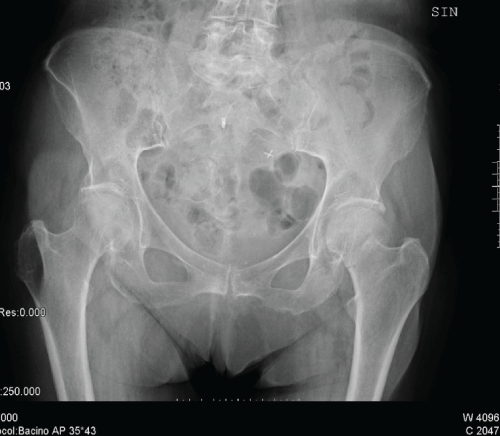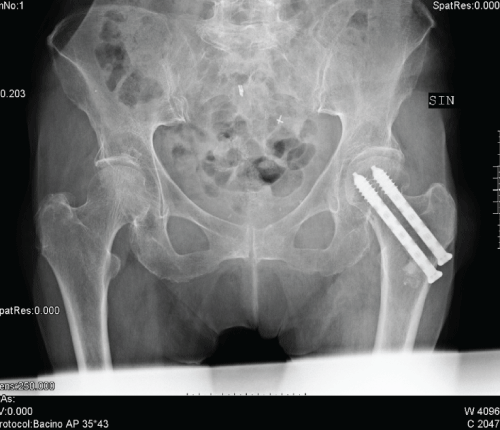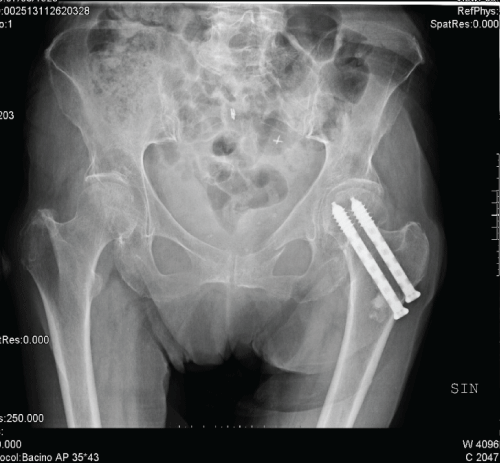Trauma Cases and Reviews
Fracture of the Femoral Neck: SOIB Method
Rinaldo Giancola1, Lorenzo Marchesi2 and Guido Antonini1*
1Ospedale San Carlo Borromeo, Milano, Italy
2Università degli Studi di Milano, Scuola di Specializzazione in Ortopedia e Traumatologia, Italy
*Corresponding author: Guido Antonini, Ospedale San Carlo Borromeo, 20147 Milano, Italy, Tel: +39 3393929918, E-mail: md.guidoantonini@gmail.com
Trauma Cases Rev, TCR-1-020, (Volume 1, Issue 4), Case Report; ISSN: 2469-5777
Received: October 01, 2015 | Accepted: December 11, 2015 | Published: December 14, 2015
Citation: Giancola R, Marchesi L, Antonini G (2015) Fracture of the Femoral Neck: SOIB Method. Trauma Cases Rev 1:020. 10.23937/2469-5777/1510020
Copyright: © 2015 Giancola R, et al. This is an open-access article distributed under the terms of the Creative Commons Attribution License, which permits unrestricted use, distribution, and reproduction in any medium, provided the original author and source are credited.
Abstract
Treating fractures of the proximal femur remains a controversial problem. Fractures of the femoral neck occur almost exclusively amongst the elderly (fractures due to bone frailty associated with osteoporosis), whereas fractures in younger people are due to high-energy trauma. The current treatment trend in clinical practice and the literature for these fractures is prosthetic replacement. In this article the authors describe the case of an 81-year-old woman who underwent osteosynthesis due to a left subcapital fracture (Garden II) using the SOIB method. The operation consisted in stabilising the fracture with SOIB screws, a special device equipped with holes along the whole length, and filling the proximal femur through the screws with an osteoconductive material. The SOIB method protected the limb from further trauma. In the literature an incidence up to 20% of contralateral hip fracure is described. Osteosynthesis of a femoral neck fracture has a higher risk of failure in the elderly due to poor bone quality: the SOIB method is a less invasive operation and thanks to the selective introduction of osteoconductive materials reinforces the osteoporotic bone, reducing complications to a minimum. In case of hip fracture a treatment for osteoporosis is mandatory.
Keywords
SOIB screw, Osteoconductive material, Osteosynthesis, Femoral neck Fracture
Introduction
In Italy osteoporosis-related proximal femur fractures account for around 90-100,000 of the estimated total 280,000 cases a year of frailty fractures, involving significant economic and professional resources. Femoral neck fractures mainly affect the elderly due to bone frailty [1].
There is extensive literature on possible treatments for these fractures, treatments that can be associated with complications and failure [2]. The main reason osteosynthesis fails in fractures of the elderly is bone frailty due to osteoporosis, which prevents the synthesis materials from effective fixation. The orthopaedic surgeon therefore increasingly opts for prosthetic joint replacement.
Prosthetic replacement is the state of the art in stage III-IV Garden fractures, whereas osteosynthesis is a possible alternative for stage I-II Garden fractures.
Case Report
We present the case of an 81-year-old woman who had an accidental fall at home on 02.10.2011 with a consequent Garden II subcapital fracture of the left femur (Figure 1). The patient was in good mental health, lucid and oriented in space/time, had no motor deficits and led a relatively active lifestyle in view of her age, although she had been complaining of problems of balance for a few months.
The patient's medical history included arterial hypertension, ventricular hypertrophy and non-insulin dependent diabetes mellitus. Blood tests showed mild leucocytosis (11000 × 103/ml) and raised PCR without a temperature, attributed to the trauma.
After the pre-operative assessments the patient underwent osteosynthesis of the fracture with two SOIB screws 6.5 mm in diameter and 80 mm and 90 mm long and the selective injection at the trochanter, neck and head of an osteoconductive substance (tricalcium phosphate and hydroxyapatite bone cement) through these screws (Figure 2). The operation was performed under spinal anaesthesia. The cutaneous incision measured around 5 cm and drainage was not required; the operation lasted 35 minutes. Post-operative haemoglobin and haematocrit levels were good and no transfusion was required. Pain control, following a 24-hour elastomeric pump delivery of ketorolac and gastro-protectants, consisted of a combination of paracetamol and tramadol at the patient's request: around 750 mg a day were taken on average. The second day the patient was sitting up and after 4 days took her first steps using a walking frame with the assistance of physiotherapists. On the fifth day after the operation the patient was transferred to rehabilitation facilities, with appropriate therapy for osteoporosis: biphosphonate and Vitamin D supplementation the rehabilitation programme comprised 40 days of partial weight-bearing after which the patient gradually abandoned support and began full weight-bearing on the operated limb. The wound showed no signs of secretion or inflammation. Clinical and radiological assessments 45 days after the operation showed an advanced state of healing of the bone and the patient reported only occasional pain in the trochanter region. At the 3-month follow-up the healing process was complete (Figure 3).
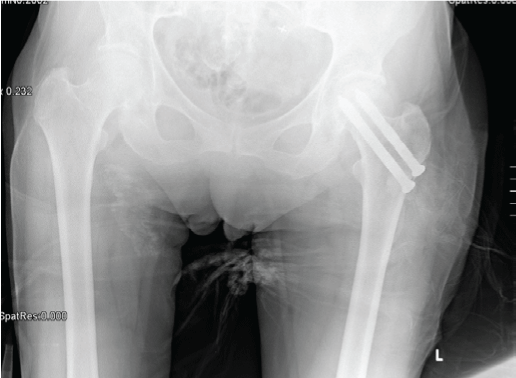
.
Figure 2: SOIB screws 6.5 mm in diameter and 80 mm and 90 mm loaded with osteoconductive substance reaching the femoral trochanter, neck and head.
View Figure 2
On 13.03.2013 (17 months after the operation) the patient was admitted to first aid service due to another accidental fall which caused bruising to the operated hip. The radiographs showed a substantially composed fracture of the left ischiopubic ramus, which did not however affect the operated femur (Figure 4).
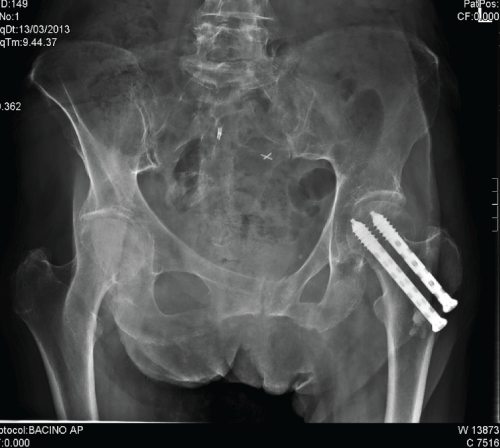
.
Figure 4: Composed fracture of of the left ischiopubic ramus (17 months after the operation).
View Figure 4
On 26.11.2013 (25 months after the operation) the patient was again admitted to first aid service following an accidental fall: the radiographs showed a fracture of the left ischiopubic ramus, which did not however affect the femur and SOIB screws implanted in 2011 (Figure 5).
In May 2014 (31 months after the operation) the patient was taken to first aid service at a different hospital following another accidental fall: a subcapital fracture of the right femur (Garden II) was diagnosed and the patient underwent hemiarthroplasty surgery (Figure 6).
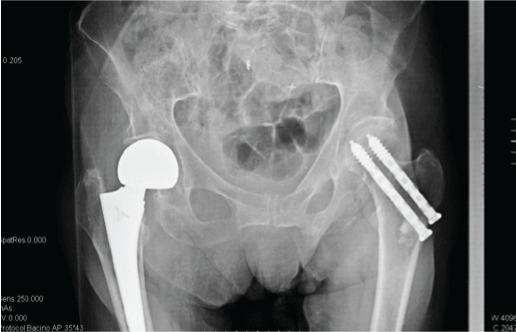
.
Figure 6: Subcapital fracture of the right femur (Garden II) was diagnosed and the patient underwent hemiarthroplasty surgery (31 months after the operation).
View Figure 6
Discussion
The literature indicates that hemiarthroplasty implants are associated with higher perioperative mortality then osteosynthesis operations [3] and the general percentage of failure in fractures of the femural neck treated with osteosynthesis with screws is reported as 5-10% in closed fractures and 20-40% in compound fractures [2].
The health costs involved in treating medial hip fractures are high: in the United States in 2010 it amounted to between 17 and 20 billion dollars, with an expected increase in the occurrence of the pathology by 2030 [4]. Given that elderly patients with a fracture of the femur neck almost always also suffer from numerous other concomitant and often major illnesses (cardiopathy, diabetes, ictus, chronic obstructive pulmonary disease, dementia), associated with equally major treatments (such as antiplatelet and anticoagulant therapies), it is felt that mini-invasive interventions should be favoured. A mini-invasive technique such as screw fixation of the femur, which respects haemostasis and thus reduces surgery time and bleeding to a minimum, may be a viable solution.
In view of the increased risks in elderly patients due to their age and general conditions, the time a patient is immobilized in bed following surgery must be as short as possible to avoid commonly occurring complications such as bed sores, respiratory and circulatory disorders, psychic alterations or urinary infections. In 2015 the American Academy of Orthopaedic Surgeons (AAOS) published guidelines based on a systematic review of over 16000 abstracts and more than 1700 articles to create 25 recommendations supported by 169 research papers [5]. This review assigns the use of osteosynthesis in the event of non-displaced fractures a moderate strength of recommendation.
The most common intervention is hemiarthroplasty, where just the femur is subject to prosthetic replacement: it is, however, an operation of major surgery requiring blood transfusions due to post-operative anaemia [6,7]. Post-operative anaemia, as well as being directly involved in possible cardiac and respiratory complications, may also cause states of delirium and can negatively affect patient outcome. A state of delirium leading to poorer patient compliance exposes the patient to greater risk. Prosthesis also involves an intrinsic risk of dislocation; the risk being higher the less time has passed since its implant. Moreover, the possibility of subsequent falls exposes the patient to possible periprosthetic hip fracture requiring major surgery to revise the prosthetic stem.
The SOIB Method combines the advantages of osteosynthesis, that is minimally invasive and preserve the patient's anatomy, with the use of biologically active substances, thus increasing implant fixation and the resistance of the cancellous bone weakened by the osteoporotic process. In this case study, the implant enabled the fracture to heal and introducing bone cement through the screws provided protection from fracture due to the subsequent falls. The two left hip traumas were not cervical or subtrochanteric fractures but the ischial and then the ileopubic ramus fractures. The bone augmetation was a protective support for the porotic and frailty bone.
It is well-documented in the literature that there is an elevated risk of controlateral hip fracture involving around 20% of patients and usually occurring in the first 3 years after the initial trauma. This also occurred in our clinical case study. The patient was treated elsewhere for the same type of fracture (Garden II) and underwent prosthetic replacement, demonstrating that the current tendency is for surgeons to opt for hemiarthroplasty.
Conclusion
A fracture of the femoral neck in the elderly is a major pathology with serious consequences from both a clinical and a socio-economic point of view.
The current trend is the use of a prosthetic implant to avoid complications associated with the poor fixation of the synthesis materials to osteoporotic bone tissue. Nevertheless, major surgery exposes the patient to risks such as anaemia, dislocation, infection and even periprosthetic fractures.
The SOIB system combines the mini-invasiveness of osteosynthesis using cannulated screws with the use of osteoconductive materials which assist the healing process and fill the osteoporotic trabeculae, thus not only ensuring the fracture heals but also protecting the hip from subsequent traumas.
References
-
Tarantino U, Cerocchi I, Celi M, Rao C (2010) Dimensione attuale del fenomeno osteoporosi in Italia. GIOT 36: 263-267.
-
Lu-Yao GL, Keller RB, Littenberg B, Wennberg JE (1994) Outcomes after displaced fractures of the femoral neck. A meta-analysis of one hundred and six published reports. J Bone Joint Surg Am 76: 15-25.
-
Bonnaire F, Straßberger C, Kieb M, Bula P (2012) Osteoporotic fractures of the proximal femur. What's new? Chirurg 83: 882-891.
-
Miyamoto RG, Kaplan KM, Levine BR, Egol KA, Zuckerman JD (2008) Surgical management of hip fractures: an evidence-based review of the literature. I: femoral neck fractures. J Am Acad Orthop Surg 16: 596-607.
-
Brox WT, Roberts KC, Taksali S, Wright DG, Wixted JJ, et al. (2015) The American Academy of Orthopaedic Surgeons Evidence-Based Guideline on Management of Hip Fractures in the Elderly. J Bone Joint Surg Am 97:1196-1199.
-
Shokoohi A, Stanworth S, Mistry D, Lamb S, Staves J, et al. (2012) The risks of red cell transfusion for hip fracture surgery in the elderly. Vox Sang 103: 223-230.
-
Dillon MF, Collins D, Rice J, Murphy PG, Nicholson P, et al. (2005) Preoperative characteristics identify patients with hip fractures at risk of transfusion. Clin Orthop Relat Res 439: 201-206.





